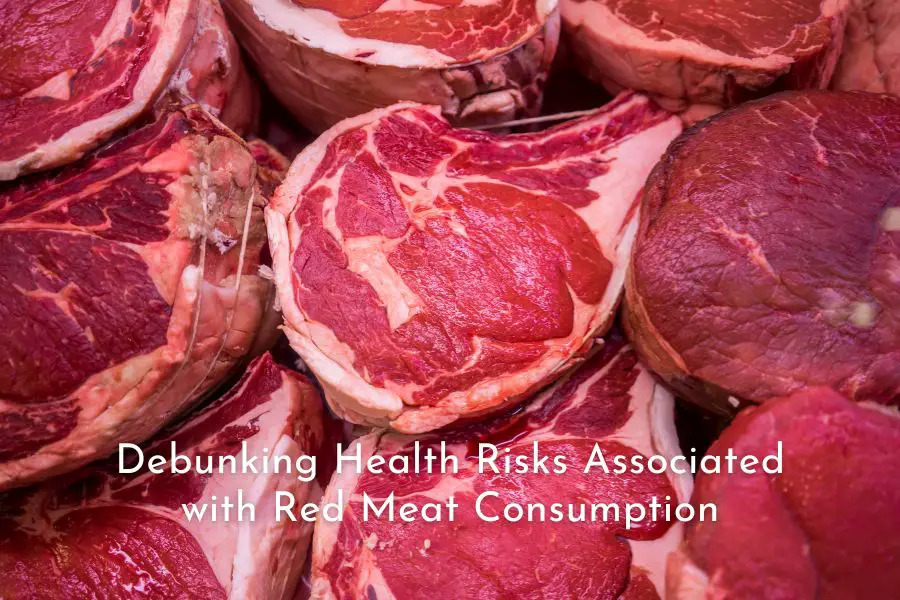Red meat has been implicated in various health issues, including heart disease, diabetes, gout, cancer, and premature death. In this article, we will examine the quality of research evidence in this particular area and dispels the misconceptions surrounding the notion that consuming red meat elevates the risk of these health problems.
Why It Is Difficult to Get Quality Research Done
Conducting quality research to establish causal relationships between dietary habits and health outcomes can be challenging due to the diversity of human population, practical constraints, as well as financial and resource constraints. As a result, we end up with poor quality evidence that doesn’t really tell us anything.
In an ideal world, if we want to establish a causal link between a dietary behavior (e.g. eating red meat or smoking cigarettes) and a health outcome (e.g. heart disease and cancer risk), we need to put a large number of people in a randomized control trial (RCT) setting which is considered the gold standard of medical and scientific research.
The key features of a randomized controlled trial are:
- Randomization: Participants in an RCT are randomly assigned to different groups. This random assignment helps ensure that any differences between the groups are due to chance rather than systematic factors, making the groups comparable at the beginning of the study.
- Control Group: In an RCT, there is a control group and one or more treatment groups. For example, if you want to look at the impact of high red meat intake on certain health risk, the control group may be put on a balanced diet comprised of a variety of animal-based and plant-based foods following the current dietary guidelines, while the treatment groups receives either high and low intake of red meat.
- Blinding: To minimize bias, RCTs often use blinding. This involves keeping participants, researchers, and sometimes even those analyzing the data unaware of who is in the control group and who is in the treatment group. When both participants and researchers are unaware of group assignments, it’s called double-blind.
- Outcome Measures: The study measures predefined outcomes to assess the impact of the dietary intervention. These outcomes are typically chosen based on the research question and the goals of the study.
Given their design, RCTs provide a strong basis for establishing cause-and-effect relationships and are considered a gold standard in evidence-based medicine.
However, in reality, it is impossible to get a meaningful number of participants and place them in a control setting for a sufficient period of time where the only difference is their levels of red meat intake.
Researchers, therefore, are forced to make do with insights they gather from observational studies which can only show associations between dietary habits and health outcomes rather than establishing any causal relationships between them. Below, we will look at why findings from observational studies aren’t that reliable.
Why Observational Studies Can’t Really Tell Us Anything
Observational studies are inherently limited in their ability to establish reliable causal relationships due to problems such as recall bias, measurement error, and the absence of randomization and control settings.
In these studies, researchers observe and analyze individuals or groups without intervening or manipulating any variables. Typically, researchers focus on observing dietary behaviors and health outcomes across a large number of individuals to explore potential associations between specific dietary habits and health outcomes.
For example, if researchers aim to evaluate whether high red meat intake increases cancer risk, in an observational study, they would observe the dietary behaviors of a group of people typically via food survey questionnaires. However, there are a number of problems with this type of study design. In particular:
- Recall Bias: In observational studies, participants may have difficulty accurately recalling past exposures, leading to recall bias. This can impact the reliability of the data collected and when input data is unreliable, findings are unreliable as well. For example, participants may be asked to recall the approximate daily servings of red meat consumed over the previous two weeks. Such retrospective estimation poses significant challenges and is prone to inaccuracies, diminishing the overall accuracy of the study’s conclusions.
- Measurement Error: Errors in the measurement of exposures or outcomes can occur in observational studies. This may include inaccuracies in self-reported data or variations in how measurements are taken.
- Selection Bias: Participants in observational studies are not randomly assigned to groups, and selection bias can occur if certain groups are more or less likely to be included in the study. This can affect the generalization of the findings to the broader population.
- Confounding Variables: One of the main challenges in observational studies is the presence of confounding variables. These are factors that are associated with both the exposure and the outcome, making it difficult to determine whether the observed association is due to the exposure of interest or the confounding factor.
Given the limitations of observational studies, especially the lack of randomization and control settings, researchers cannot ensure that groups being compared are similar in all aspects except for the variable of interest such as the level of red meat intake.
As a result, it is impossible to provide conclusive evidence of cause-and-effect relationships in such human health studies and all we have are associations which aren’t that helpful in helping us making decisions with regard to our health.
For instance, consider a scenario where a high correlation is observed between ice cream sales and deaths from drowning. It is evident that ice cream sales do not cause drownings, nor do drownings cause an increase in ice cream sales. It is crucial to recognize that correlations or associations do not imply causation. Therefore, interpreting observational study results requires caution, emphasizing the need for a comprehensive understanding of the limitations when making health-related decisions.
Examples of Flawed Observational Studies
Red Meat and Lung Cancer
In a systematic review of observational studies examining the relationship between meat consumption and lung cancer risk, researchers found that “a high intake of red meat may increase the risk of lung cancer by about 35%, while a high intake of poultry decreases the risk by about 10%“. [1]
However, in another observational study with 73,187 participants, it was found that there was an adverse association between total red meat intake and lung cancer risk amongst men. In simple terms, the more red meat those men consumed, the lower the likelihood of them developing cancer. The authors also found no positive association between total red meat intake and lung cancer risk in women. [2]
Such is the nature of observational studies— results are sample-dependent and may present conflicting findings. They only establish links and associations but can say nothing about what causes what which is essential in helping us making informed decisions regarding our health.
So far, we have no quality evidence that shows eating red meat increases our risk of developing lung cancer. You don’t need to stop eating red meat or consuming saturated fats if you are concerned about lung cancer. However, if you smoke, the available evidence strongly suggest that you should quit smoking. [3, 4, 5, 6, 7, 8]
If quitting immediately is difficult, you may want to consider a gradual transition using nicotine pouches like Zyn pouches, nicotine patches, gum, nasal spray or nicotine inhaler. [9]
While nicotine is the addictive substance that keeps people smoking, nicotine itself is relatively harmless. It is the harmful chemicals produced when tobacco burns that cause serious health damage. Tobacco smoke contains over 7,000 chemicals, of which at least 69 are known to cause cancer. These chemicals include, for example, tar (coating and damaging lung tissues), carbon monoxide (poisonous gas), benzene (carcinogen), polycyclic aromatic hydrocarbons (damaging DNA and causing cancer), formaldehyde (preservative and carcinogen), and arsenic (poisonous and causing damages to kidneys, liver, and nervous system). [10, 11, 12, 13, 14, 15]
Red Meat and Heart Diseases
Observational studies have also found positive associations between red meat intake and incidence of heart disease.
For example, in a cohort study of 43,272 US men over the 1986-2016 period, researchers found that “total, unprocessed, and processed red meat intake were each associated with a modestly higher risk of coronary heart disease.” [16]
Similarly, a systematic review and meta-analysis of 70 observational studies found that “Red meat consumption was positively associated with cardiovascular diseases, cardiovascular disease subtypes, type two diabetes mellitus, and gestational diabetes mellitus.” [17]
However, a landmark systematic review and meta-analysis of observational studies showed no association between saturated fat [a significant component of red meat] consumption and (i) all-cause mortality, (ii) coronary heart disease, (iii) coronary heart disease mortality, (iv) ischaemic stroke or (v) type 2 diabetes in healthy adults. [18, 19]
In another study that aims to objectively and quantitatively assess the risk–outcome pairs, researchers gave the association between unprocessed red meat consumption and ischemic heart disease a two-star rating and considered it to be “on the threshold between weak evidence and no evidence of association.” [20]
In addition, a systematic review of 15 randomized controlled trials (gold standard of scientific research) with 59,000 participants found no significant benefit from reducing saturated fats (i.e. red meat consumption) on heart attacks, strokes and all-cause mortality. [21]
If red meat and saturated fat consumption indeed cause heart diseases, we would have seen exceptionally high death rates due to heart diseases in groups that traditionally followed meat-centered diets like the Inuit, the Masai, and the Brazilian Gauchos but that has not been what we have seen. However, following an increase in the intake of refined carbohydrates, research shows that their health began to decline. [22, 23, 24]
Red Meat and Cancer
In addition to lung cancer, many observational studies have found an association between high intake of red meat and many types of cancer, including bowel cancer, colorectal cancer, breast cancer, prostate cancer, pancreatic cancer, endometrial cancer, and colon cancer. Many health organizations are currently advising people to limit their red meat consumption to reduce cancer risk based on those findings. [25, 26, 27, 28, 29, 30, 31, 32, 33]
For example, a review of studies in relation to red meat and processed meat consumption and cancer incidence found that “high red meat intake was positively associated with risk of breast cancer, endometrial cancer, colorectal cancer, colon cancer, rectal cancer, lung cancer, and hepatocellular carcinoma, and high processed meat intake was positively associated with risk of breast, colorectal, colon, rectal, and lung cancers. Higher risk of colorectal, colon, rectal, lung, and renal cell cancers were also observed with high total red and processed meat consumption.” [34]
Likewise, a review of epidemiological studies on the association between intake of red meat and processed meat and colorectal cancer found that “red meat and processed meat convincingly increases colorectal cancer risk by 20-30%.” [35]
However, a review of 25 independent non-overlapping study populations found that “the available epidemiologic data are not sufficient to support an independent and unequivocal positive association between red meat intake and colorectal cancer.” [36]
Similarly, a review of 40 studies using animal models or cell cultures also found that “there is currently insufficient evidence to confirm a mechanistic link between the intake of red meat as part of a healthy dietary pattern and colorectal cancer risk.” [37]
The conflicting findings from observational studies and their meta-analysis demonstrate the unreliability of the evidence from this type of study.
A rigorous and comprehensive review of available evidence by a 14-member international team led by Dalhousie University and McMaster University in Canada and published in the prestigious Annals of Internal Medicine in 2019, however, did not find the evidence supporting the recommendation to limit meat intake. [38]
Team leader, Bradley Johnston, an associate professor of community health at Dalhousie University, said that “Based on the research, we cannot say with any certainty that eating red or processed meat causes cancer, diabetes or heart disease.” [39]
In this study, rigorous systematic review methodology and GRADE methods to rate the certainty of evidence for each outcome were adopted. A panel of 14 members, including 3 community members, from 7 countries (who have been screened for potential conflicts of interest) voted on the final recommendations that “adults continue their current unprocessed red meat consumption and current processed meat consumption.” [40]
Professor Johnston also noted that “Among 12 randomized control trials enrolling about 54,000 individuals, we did not find a statistically significant or an important association in the risk of heart disease, cancer, or diabetes for those that consumed less red and processed meat.”
In addition, using a novel approach called “burden of proof risk function methodology”, researchers at the University of Washington’s Institute for Health Metrics and Evaluation conducted an extensive review of decades of research on red meat consumption and its associations with various health outcomes. Through this, they developed a novel rating system to communicate health risks. Overall, their findings largely alleviate concerns regarding the consumption of red meat.
We found weak evidence of association between unprocessed red meat consumption and colorectal cancer, breast cancer, type 2 diabetes and ischemic heart disease. Moreover, we found no evidence of an association between unprocessed red meat and ischemic stroke or hemorrhagic stroke.
Lescinsky et al (2022)
Conclusion
There is no doubt that our ancestors ate a lot more meat than most people do today. However, they didn’t succumb in the millions to diabetes, heart diseases, and myriad types of cancer; instead, they thrived and prospered. In our view, this serves as the most reliable long-term evidence upon which we should rely. [41]
Although observational studies can offer valuable starting points for generating hypotheses and exploring potential relationships between variables, they can only demonstrate associations between variables and cannot establish a clear cause-and-effect relationship. Therefore, findings from these studies should be used with extreme caution when determining our dietary choices
Other posts you might be interested in:
Is Carnivore the Best Anti-Aging Diet Around?
Is the Carnivore Diet Okay for High Blood Pressure?
Can the Carnivore Diet Help Fix Your Eczema?
How Pablo Kelly Beat Brain Cancer with a High-Fat Meat-Based Diet
Can the Carnivore Diet Reverse Type II Diabetes?
10 Tips to Sneak More Organ Meat into Your Children’s Diet
Disclaimer: The information in this post is for reference purposes only and is not intended to constitute or replace professional medical advice. Please consult a qualified medical professional before making any changes to your diet or lifestyle. Please check out our disclaimer for more detail.





